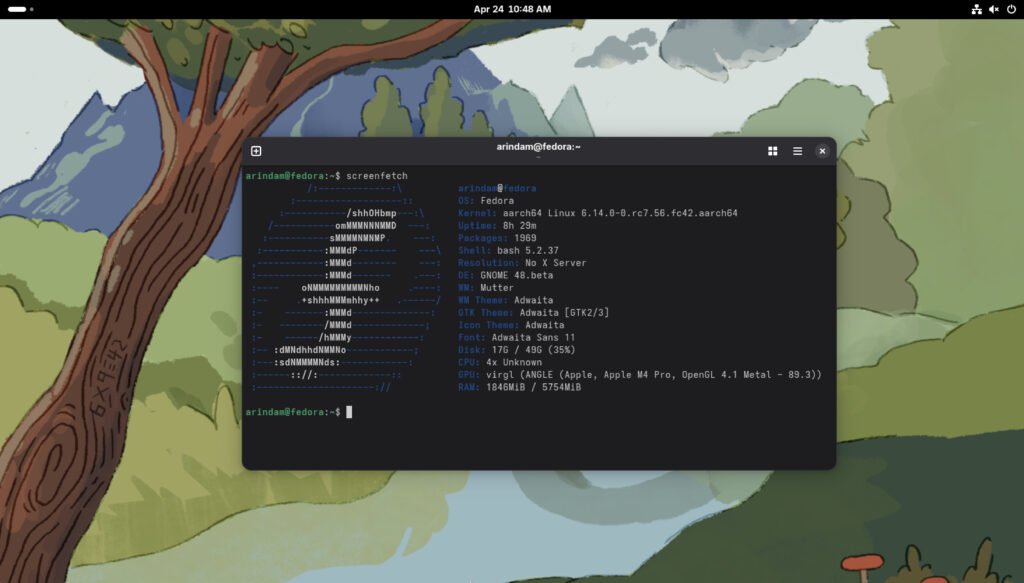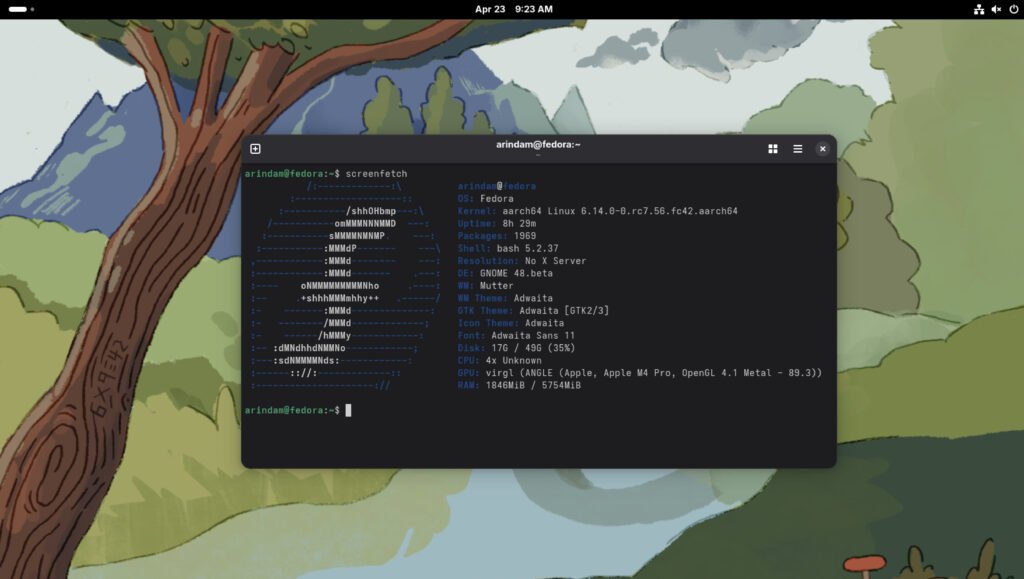Fedora 42 Unveiled: COSMIC desktop, revamped installer, and Apple Silicon support steal the show.
The Fedora Project has officially released Fedora 42, bringing a host of exciting updates and new features to its diverse line up of “spins”, including Fedora Workstation, Fedora KDE Plasma Desktop, Fedora Server, Fedora IoT, Fedora Silverblue, Fedora Kinoite, and various flavours featuring environments like Xfce, MATE, Cinnamon, LXQt, Budgie, Sway, and the newly introduced COSMIC desktop.
Available for x86_64, Power64, and ARM64 architectures, as always Fedora 42 delivers cutting-edge improvements and being the pioneer for new tech adoption in Linux landscape.
Table of Contents
Fedora 42: Best Feature Highlights
Fedora KDE Plasma Desktop is now priority
Fedora 42 marks a significant milestone for the KDE Plasma Desktop, which is now on par with Fedora Workstation in terms of support and priority. Previously, GNOME-specific issues could delay a release, but now KDE-related critical bugs are also considered release-blocking.
Additionally, Fedora KDE Plasma Desktop now supports the Power architecture (ppc64le), enabling users of OpenPOWER systems like the Talos Workstation to leverage a full suite of KDE applications, including KDE PIM for email and productivity. Live builds with KDE are also available for these systems, simplifying installation.
This is really a milestone, showing the maturity & stability of the KDE Plasma desktop environment with recent few years of quality release. This effectively gives you more confidence to choose KDE Plasma as primary desktop with Fedora as base.
Introducing COSMIC Desktop Spin
Fedora 42 introduces official Spin builds featuring the COSMIC desktop environment, developed by System76 in Rust. COSMIC offers a unique hybrid tiling and stacking mode, allowing users to group windows like browser tabs and integrate them with virtual desktops for a highly customizable workflow.
Since COSMIC desktop comes with its unique set of features, developed from ground up using Rust programming language, it becomes an effective option with Fedora base now. Those who wants a replacement for GNOME or KDE but want a Fedora base, this is a perfect combination. Thanks to both the teams for bringing this to the users.
GNOME 48, Xfce 4.20, and LXQt 2.1 Updates
Fedora Workstation now runs on the GNOME 48 branch, bringing refined visuals, improved performance, and enhanced accessibility features. Similarly, the Xfce 4.20 and LXQt 2.1 spins benefit from updated desktop environments, offering lightweight yet feature-rich experiences for users with older hardware or those prioritizing efficiency.
Revamped Anaconda Installer with Web Interface
The Anaconda installer in Fedora Workstation has undergone a major overhaul, replacing its GTK-based interface with a web-based interface built using React, PatternFly, and Cockpit components. This wizard-style interface guides users through installation steps sequentially, prioritizing simplicity and clarity. Key features include:
- Automated disk partitioning as the default, making setup easier for novices.
- Support for reinstallation to restore damaged systems.
- Dual-boot mode for running multiple operating systems.
- Transition to the Wayland protocol, eliminating X11 dependencies.
- Remote installation via Gnome Remote Desktop (RDP) instead of TigerVNC.
Unified /usr/bin and /usr/sbin Directories
Fedora 42 merges the /usr/bin and /usr/sbin directories, replacing /usr/sbin with a symbolic link to /usr/bin. This change eliminates the outdated practice of separating executable files, simplifying package maintenance and improving system predictability.
Enhanced Flatpak and Disk Management
New flatpak and diskadmin groups allow unprivileged users to manage Flatpak packages and external drives without needing administrative (wheel group) access. Users in the wheel group can also unlock and mount LUKS-encrypted drives without password prompts.
This helps IT admins, users to manage apps and storage safely without exposing unnecessary administrative privileges. This is particularly useful for shared or enterprise systems.
Optimized Executable Files for x86-64 Architectures
Fedora 42 allows packages to include optimized executable files for x86-64-v2, v3, and v4 microarchitectures. While performance gains typically hover around 10%, some workloads see improvements up to 120%, depending on the package and hardware.
Users with modern CPUs can experience noticeable performance boosts in specific applications, making Fedora a strong choice for performance-sensitive tasks like video editing, gaming, or scientific computing.
EROFS and Composefs for Live and Atomic Builds
Live builds have transitioned from SquashFS to the EROFS file system, offering faster random access and throughput despite slightly larger image sizes. Atomic Desktop editions (e.g., Fedora Silverblue, Kinoite) now use the Composefs file system, enabling read-only root partitions with integrity verification for enhanced security.
EROFS improves the performance of live media, making it faster to boot and test Fedora. Composefs strengthens the security and reliability of atomic editions, appealing to users who prioritize immutability and system integrity.
Fedora Asahi Remix 42 for Apple Silicon
The Fedora Asahi Remix 42 targets Mac computers with Apple M1 and M2 chips, offering robust support for sound, camera, Wi-Fi, Bluetooth, USB-C, and MagSafe. It includes the Calamares installer and supports OpenGL 4.6, OpenGL ES 3.2, and Vulkan 1.4 for graphics. The FEX emulator enables x86_64 application compatibility.
Other Notable Updates
- SDL 3 with Wayland as the default for multimedia applications, improving graphics performance.
- DNF5 now manages PGP keys automatically, simplifying repository updates.
- RPM supports user/group creation via Sysusers.d and enables Copy-on-Write with Btrfs.
- Updated packages: LLVM 20, GCC 15-test, glibc 2.41, Go 1.24, Ruby 3.4, PHP 8.4, and more.
- FEX emulator for x86 compatibility on ARM64, integrated into KDE builds.
- Expanded webcam support for MIPI interfaces and VM memory encryption with AMD SEV-SNP and Intel TDX.
- Plymouth now uses simpledrm for faster boot splash screens.
- RPM Fusion repositories add multimedia IronPython support for multimedia and proprietary drivers.
Download
You can download the workstation edition (GNOME) of Fedora 42 beta from the below page:
You can download the spins from the below torrent files.
Conclusion
Fedora 42 is a significant release that balances new tech adoption with usability. From the elevated KDE Plasma Desktop and COSMIC Spin to the revamped Anaconda installer and Apple Silicon support, it caters to a wide range of users. You can have any combinations of choices as Fedora base.

